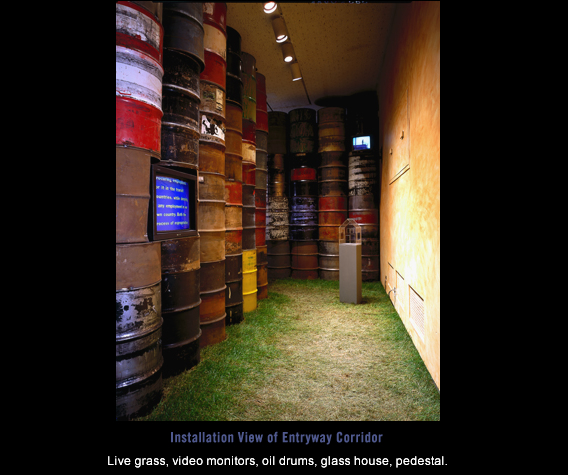








The viewer enters through the doorway into a narrow corridor blocked off with metal barrels — the ubiquitous barrels, used to close off the streets in the refugee camps, to hold the people in or out as fits the needs of any particular occasion. Sod carpets the floor beneath the viewers’ feet, an allusion to the greening of the desert to which the Israelis lay claim. In this corridor, directly in front of the doorway is a monitor showing a rolling text of excerpts taken from the writings of Theodor Herzl, David Ben-Gurion and others related to the territories that were given over for the new Jewish homeland and a Palestinian state by the British Mandate. At the end of this corridor is a glass house on a pedestal with an audio track playing inside. The viewers must bend down to hear the sounds of water dripping and voices. On a small surveillance-like monitor hanging over the corridor, soldiers insistently patrol.
The corridor is set up to be claustrophobic, a physical space that relates to a closed mindset such as that most US citizens have had toward the Palestinians. The tendency to see the Palestinian-Israeli conflict with blinders on is something that has been prevalent since the forties even though this country sends millions of dollars to Israel, supporting the continuation of the 25-year occupation of Gaza and the West Bank.
As the viewer leaves the tight corridor, the balance of the space opens up. The second room is fairly dark. A video projection appears on the far wall with blended images from Gaza and the West Bank, many of these images are landscapes and cityscapes interspersed with people’s faces and the ever-watchful soldiers. Sound emanates from behind the wall on which the video is projected, a repetition of the sound in the glass house, amplified and reverberating.
In the center of the space is a circular wall made of stones. This circle has openings cut on a diagonal into it. The stone wall alludes to the terraces that one finds everywhere in these lands, terraces built by Arabs to both clear and maintain arable land and to demarcate the boundaries of property. Embedded in this stone circle are four video monitors showing a videotape of the living conditions of the Palestinians under occupation. Several interviews are interspersed with the other footage. The video footage is a blend of documentary and interpretive styles.
Behind the stone circle, a group of sticks of varying heights stand upright, shaped and painted to resemble houses at the top. These represent the settlements that encircle the Arab towns and camps in the West Bank and Gaza. There are twenty-five sticks in all, one for every year of the occupation.
The entire large space is guarded by two more video monitors, which also show the video soldier sentinels. This creates a situation in which it is impossible to move anywhere in the space without being observed by an armed video guard.
The final element is another soundtrack that fills the space with Palestinian voices telling stories of their lives and hopes for the future.
1992